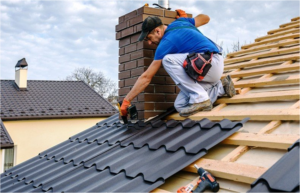Most people associate roofs with metal roofing or shingles. What many people don’t know is that there’s an additional layer of protection on top of your roof deck and underneath the roof covering. This protects your home from moisture damage. It’s called roofing underneath.
Learn more about this crucial component of your roof’s structure.
What is a Roofing Underlayment?
The roofing underlayment, also known as roof deck or plywood, is the layer between the roof shingles and the roof sheathing or roof deck. It is usually either OSB or plywood. It is installed directly on the roof deck, providing a second layer of protection against the elements including rain, snow and wind.
Types of roofing underlayment
There are two types of roofing underlayment.
- Felt
- Synthetic
Every product has its advantages and disadvantages. The type of product you choose will depend on where you live, the roofing materials used, your budget, and any suggestions from your contractor.
Felt Roofing Underlayment
Felt roofing is the oldest type of roofing underlayment. It is made by saturating paper with asphalt or fiberglass mat.
There are two types of felt roofing underlayment: No.15 and No. 30. 30 felt. Comparable to No. 15 felt, No. 30 felt is thicker and stronger than 15 felt. It may also be less susceptible to being ripped off during installation.
Pros
The primary advantage of using felt roofing underneath payment is its cost. Felt roofing underlayment is often less expensive than synthetic, making it a popular choice for budget-conscious homeowners.
Cons
There are many disadvantages to using felt roofing underlayment. Traditional felt roofing underlayment can’t be left out for more than a few hours. The heat can cause the material to dry out and leach oils. This could impact the felt’s ability to protect against moisture.
Another drawback to felt underlayment is:
prone to being torn in high winds or during the strain of installing.
When exposed to moisture, the felt can absorb water and create wrinkles, making it difficult for the shingles lay flat. To ensure maximum protection, shingles should always be installed as soon as the felt roofing underlayment has been installed.
Felt underneathlayment is heavier which can make it more difficult for roofing contractors drag rolls up a ladder to a roof.
The surface is slippery, making it sometimes more difficult to install.
Less material per roll is also a result of the weight. This results in more seams than a single course that has no laps.
Felt Roof Underlayment and Warranties
Felt underlayment may be installed to prevent you from receiving the manufacturer’s warranty. This may lead to your need for synthetic underlayment.
Synthetic Roofing Sublayment
Many roofers choose to use synthetic roofing underneath for enhanced water resistance and protection from the elements. These products are often made of long-lasting polymers that provide strength and durability. This underlayment is usually water-resistant and, when installed correctly, offers greater protection against the elements than felt.
Different manufacturers make synthetic roofing underlayment materials differently. This means that they may have different performance levels. Talk to a trusted contractor to help you choose the best roofing material to protect your home.
Pros
Synthetic roof underlayment is better than felt for four reasons. Synthetic roofing underlayment has the following advantages over felt:
- Tough
- Installation is quick
- Secure
- Repels water
Synthetic underlayment is tougher than felt and has an exceptionally high tear strength.
Synthetic roof underneath is very durable. This is particularly useful if you have a little time before your roof covering is installed.
The synthetic underlayment is also resistant to boots traffic. This is especially important for roofing contractors who are walking on the surface while it is being installed. Owens Corning Roofing calls this “use after abuse”. The product can still perform as intended even after being subject to a lot of abuse during installation.
Also, synthetic roofing underlayment tends to be:
Lighter* – Some cases up to four times lighter
Easy to install. Synthetic roofing underlayment is faster than felt. Because it has more material per roll (compared to felt), your roofers will need to make fewer trips up the ladder. This may save them time and help the job move faster . A typical 2700-square-foot home may require three rolls of synthetic underlayment, while 14 rolls of No.30 felt would cover the same area.
Safe Synthetic underlayment can also be beneficial for worker safety. Many synthetic roofing underlayments including Owens Corning’s, have slip-resistant surfaces that allow for better walking. It is also marked with overlap guides and indicators that indicate where fasteners should go, which helps to ensure consistency and accuracy in installation.
Moisture-resistant– Unlike felt roofing products that absorb water, synthetic roofing underneathlays are designed to repel water. This is especially important for homeowners who are concerned about moisture infiltration.
Synthetic underlayment is made from plastic and has a higher resistance to mold growth than felt.
Cons
Although synthetic roofing underlayments are often competitively priced, they can be more expensive than felt. However, the upfront investment in better quality roofing materials could help you save money later. It’s hard to beat the comfort of knowing your roof is adequately protected from water.
The right underlayment for your roof
There are many things to consider when choosing the right type of underlayment for your roofing project. Synthetic roofing underlayment offers many benefits over felt. It can be a good investment to protect your roof from moisture and water infiltration.
This post was written by Ted Williams! Ted is the owner of A Old Time Roofing which is the premier roofing contractor in Clearwater FL! Ted is a Master Elite Weather Stopper GAF Roofing Contractor, a double award winner of Best Steep-Slope Contractor from GAF and achiever of Master Elite Consumer Protection Excellence from GAF. He has been serving the Pinellas County area since 1978. Old Time Roofing has a tradition of quality workmanship, servicing residential and commercial properties.




